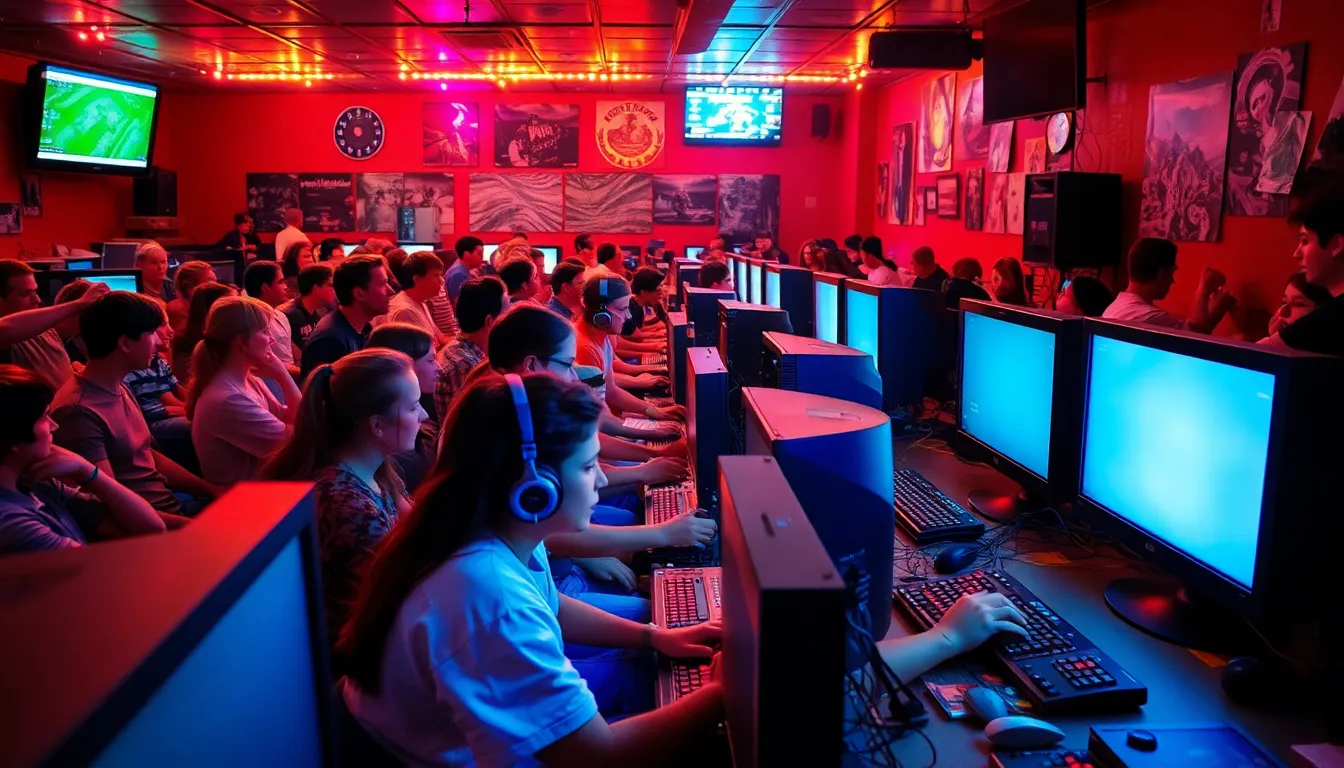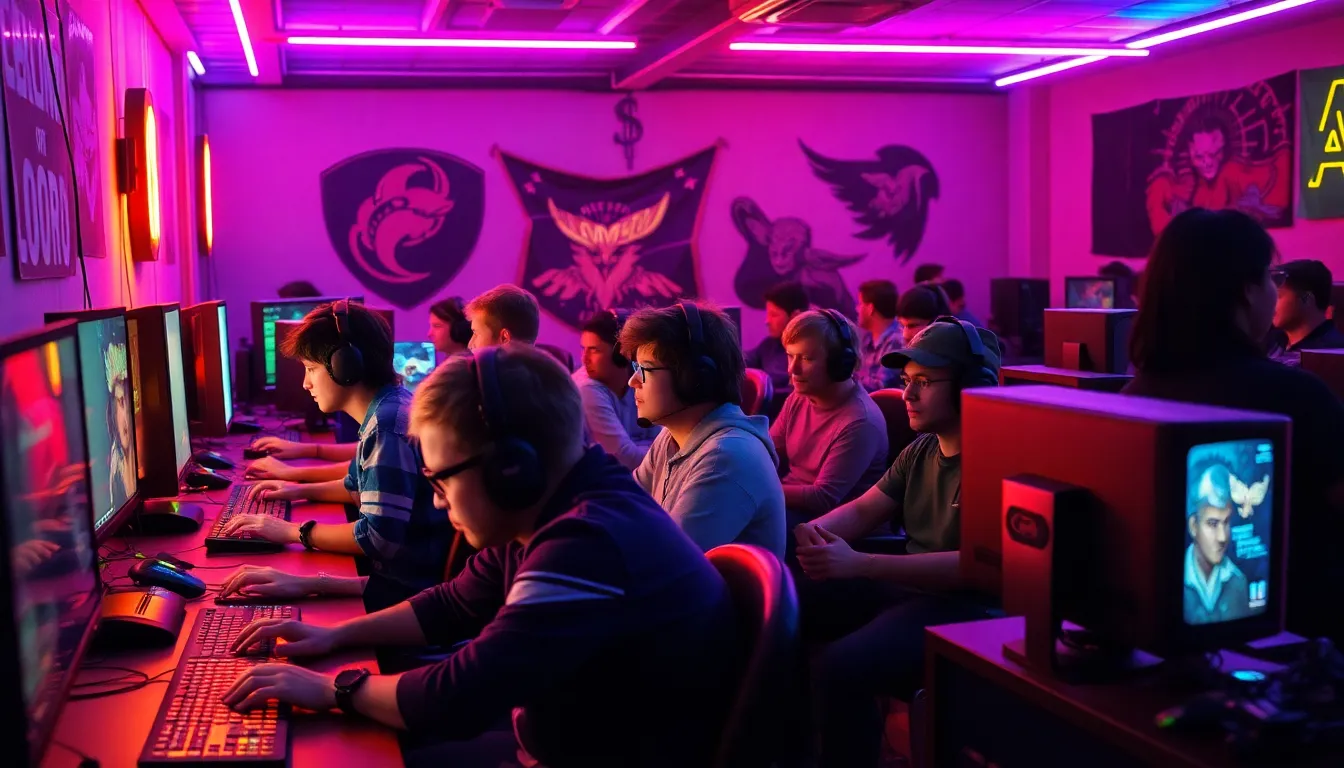From pixelated battles in basements to sold-out arenas, the journey of esports is nothing short of legendary. It all began with a handful of enthusiasts huddled around arcade machines, but now it’s a global phenomenon that rivals traditional sports. Who would’ve thought that watching others play video games could turn into a multi-billion-dollar industry?
Esports has evolved into a cultural juggernaut, complete with professional teams, sponsorships, and even its own Hall of Fame. As players like Faker and Dota’s OG become household names, the history of esports reveals a tale of innovation, competition, and a sprinkle of chaos. Buckle up as we dive into the wild world of esports history, where every match is a chapter and every player a potential legend.
Table of Contents
ToggleOrigins of Esports
Esports roots trace back to the earliest days of video gaming. From small arcade gatherings, competition evolved into organized events that fostered community engagement.
Early Video Games and Competitions
Pong, released in 1972, marked one of the first competitive video games. Players frequently gathered in arcades to showcase skills and challenge each other. In 1980, the Space Invaders Championship drew over 10,000 participants, setting a precedent for future tournaments. The evolution continued with the introduction of home consoles, allowing more players to engage in competitive gaming. Titles like Street Fighter and Mortal Kombat attracted local tournaments. Competitors began forming communities centered on their favorite games, laying the foundation for what would become the esports culture.
Landmark Tournaments
Nintendo’s 1990 championship became a pivotal moment in the evolution of esports. This event attracted media attention, creating awareness around competitive gaming. By 1997, the Red Annihilation tournament signaled the rise of professional-level competition, offering a significant cash prize. The Sense Arena World Cup followed in 2000, attracting thousands of participants and showcasing games like Quake III Arena. These landmark tournaments established key practices in esports and laid the groundwork for the multi-million dollar industry seen today.
Growth of Esports in the 1990s


The 1990s marked a pivotal era in the growth of esports, characterized by increased participation and the advent of organized competitions.
Rise of Competitive Gaming
Competitive gaming flourished during the 1990s as enthusiasts gravitated toward multiplayer titles. Games like Quake and StarCraft became staples in the competitive scene, drawing large audiences. Major tournaments offered significant cash prizes, spurring increased investment from players and sponsors. The Cyberathlete Professional League, established in 1997, played a crucial role, featuring international events that showcased talent. Many players, including notable figures like Fatal1ty, began to gain recognition, establishing early professional identities in the gaming world.
The Role of LAN Parties
LAN parties emerged as vital gathering points for gamers, enabling face-to-face competition. Players would connect their computers in local venues, creating an electrifying atmosphere. Events often attracted hundreds of participants, fostering camaraderie and spirited competition. These parties facilitated the sharing of strategies and formed the foundation for lasting friendships among gamers. As the popularity of LAN gatherings grew, they paved the way for larger organized tournaments and contributed to the esports community’s sense of identity and belonging.
The 2000s: Mainstreaming of Esports
The 2000s marked a significant turning point in the growth of esports, transforming competitive gaming into a mainstream spectacle. As technology advanced, online gaming gained traction, leading to unprecedented player engagement and viewership.
Emergence of Online Gaming
Online gaming platforms emerged as vital catalysts for the expansion of esports during this decade. Titles like Counter-Strike and World of Warcraft attracted millions of players, establishing communities that engaged in competitive play. Gamers accessed these platforms easily, fostering connections worldwide. Events hosted on platforms like ESL began to draw substantial audiences, with millions tuning in to watch live streams. Subscriber numbers on sites like Twitch skyrocketed, illustrating a growing appetite for esports content. The rise of online tournaments also democratized competition, allowing amateurs to compete alongside seasoned professionals, blurring the lines between casual play and serious competition.
Sponsorship and Professional Teams
Sponsorship deals began to reshape the esports landscape in the 2000s, attracting significant investment. Major brands recognized the potential of esports and partnered with professional teams, enhancing their visibility. The formation of teams like Team 3D and Fnatic exemplified the shift toward organized play. These teams built identities, attracting dedicated fans. Cash prizes from tournaments reached hundreds of thousands of dollars, incentivizing talent and ambition. Major events, such as the World Cyber Games, attracted international sponsors, highlighting the commercial viability of esports. Revenue from sponsorships spurred the growth of professional leagues, solidifying esports as a legitimate industry.
The Evolution of Esports in the 2010s
The 2010s showcased remarkable growth for esports, with vibrant competitions and a surge in viewership transforming the landscape of competitive gaming.
Major Game Titles and Their Impact
League of Legends emerged as a dominant force, drawing millions of players and creating a robust esports scene. Dota 2 also made waves with its massive prize pools, particularly from The International tournament, which reached over $34 million in 2019. Overwatch entered the fray, combining team-based mechanics with visually stunning gameplay, capturing the attention of fans and sponsors alike. Counter-Strike: Global Offensive continued to thrive, reinforcing its status as a staple in competitive gaming. Such titles not only elevated player engagement but also helped foster a sense of community among gamers and spectators.
Streaming Platforms and Audience Engagement
Streaming platforms revolutionized how audiences engaged with esports. Twitch led the charge, becoming the go-to platform for live streaming matches and fostering content creation. Viewers flocked to channels featuring popular streamers and tournaments, with concurrent viewership often reaching into the hundreds of thousands. YouTube Gaming also gained traction, allowing content creators to share gameplay highlights and tournament recaps. As esports events increasingly secured broadcasting deals, audiences enjoyed greater access to live matches and expert commentary. The interactive nature of these platforms encouraged fan participation, further solidifying the relationship between gamers and viewers.
Current Trends and Future of Esports
Esports continues to grow, driven by global interest and advancements in technology. The future promises further expansion as competitive gaming captures attention across diverse demographics.
Global Tournaments and Reach
Major tournaments attract millions of viewers and participants across the world. Events like The International and the League of Legends World Championship showcase top talent and offer massive prize pools. The International 2019 reached over 1 million concurrent viewers with a prize pool exceeding $34 million. Emerging regions, such as Southeast Asia and South America, are gaining traction, further diversifying the esports audience. Engagement in these tournaments often extends beyond just watching; fans actively participate through social media and interactive platforms, enhancing community involvement. Partnerships with traditional sports teams and organizations signal growing recognition of esports as legitimate entertainment.
The Role of Technology in Esports
Technology plays a pivotal role in shaping esports dynamics. Rapid advancements, including high-speed internet and streaming platforms, revolutionize how players compete and audiences engage. Live streaming services like Twitch allow fans to watch matches in real-time, fostering a deeper connection between players and viewers. Virtual reality and augmented reality technology promise immersive experiences that could redefine gameplay and spectator experiences. Enhanced data analytics aids teams in strategizing, giving them a competitive edge. As these technologies evolve, the potential for esports to innovate and captivate larger audiences becomes evident.


